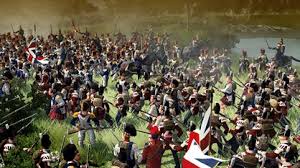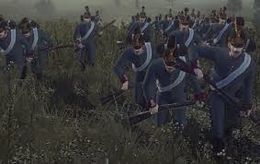The Battle of Welleire
| The Battle of Welleire | |||||||
|---|---|---|---|---|---|---|---|
| Part of Ulmur-Lillian War | |||||||
Ulmurian Forces Under Louis Calraille engage Nvradian Forces holding their ground. |
|||||||
|
|||||||
| Belligerents | |||||||
| Ulmur | |||||||
| Commanders and leaders | |||||||
| Francois Dubois | |||||||
| Units involved | |||||||
| Unknown Infantry Regiment | |||||||
| Strength | |||||||
| 150,000 Men 200 Artillery | 175,000 soldiers | ||||||
| Casualties and losses | |||||||
| Dead: 70,000 | Dead: Over 50,000 |
||||||
Contents
Summary
The Battle of Welleire was a engagement between Ulmurian forces under Francois Dubois and Nvardian Forces under Wilhelm von Hurpitz directly after The Nasoruga Expidition. Wilhelm had taken La Catteire, and wished to go further. He pushed on the Dubois-commanded city of Welleire.
Background
This battle was the third in a series of engagements between the militaries of Nvrads and Ulmur. These engagements began when Nvrads, then the kingdom of Leuen, propsed a unification of a Nvradian State with Ulmur, who refused harshly.
Opening Engagement
First Encounter
At 4:40 P.M., On 15 April 1782, the 7th Scouts Battalion of Nvrads scouted out and was engaged by a Ulmurian Infantry Battalion. Sappers Built Cover and the Nvradians dug in and waited for reinforcements, stated to come by night.Reinforcements Arrive
The first available units to come to the scouting column's aid were the leading battalions of the 9th Lineinfanterie Army. These units were equipped with the main battle grenadiers in service with the 10th Core, the Linengrenaders. The high-explosive grenadess and camoflaugey uniform were able to inflict heavy Ulmurian casualties, And sustaining themselves, while relieving the ravaged 7th Ragtag Battalion the Grenadiers Square the Scouts until wounded and dead are evacuated. Other battalions arrive and reliving the two battalions and create a defensive line, while Ulmurian battalions and artillery have arrived, along with Nvradian Artillery, and the fight would move over the night.
Later in the morning of the next day on the 16th, a Ulmurian bombardment begins on Nvradian forces, which is returned by another bombardment, keeping the main artillery battalions distracted, along with their guards as the 7th Battalion was moving up. 10th Core Releif moves from the flank, cutting off artillery from supplies and securing the artillery. The 7th and Nvradian Artillery advances while the 10th moves from the rear. The Ulmurians are forced to retreat all their wares that are remaining to Welleire.
Main Engagement
Ulmurian forces moved rapidly forward with a surprising amount of calvary and artillery, with Nvradian forces had no idea this would happen, and were completelhy unprepared and are forced back, and the Ulmurian forces organize in case of a counterattack from enemy forces; and the 7th Batallion and 10th Core call for releif.
Counterattack
At roughly 6 a.m, on the 17th, Battalions that hadn't left for the front and stayed in the trenches or the artillery stationed behind the trench revved up and began to move out. The 13th Red Guard was tasked with the second flanking of Welleire and assaulting once they arrived on the western-most edge of the town, while the 7th Nvradian Battalion was responsible for attacking head-on with the brunt of the manpower of the 11th Infantry, which had arrived with the 13th Red Guard.. The 10th Core met intense resistance on the left flank and seiged the western trenches with the calvary that finally joined the fight. Once they reached their stopping point, the core stayed there, keeping open teeth for defense. The 13th Red Guard met little to NO resistance at it's attack, and moved into western Welleire, holding it's position there.The 10th begin a artillery bombardment on the trenches leaving enemy forces exposed, quickly devolving into a melee engagement with artillery support on the 10th's side. Calvary forces had arrived to the line, not moving into the battle immediately until a few minutes after they arrived, changing the tide. As it was a melee battle and calvary could ride higher than the infantry, the Ulmurians resorted to the bayonets they had been using, which failed. The swift movement of the calvary quickly overran the trench by 4PM, and they rush into eastern and southern Welleire.
The trenches on the western, southern, and eastern sides of the town were quickly overrun by advancing Nvradian infantry supported by Artillery and Calvary. Retreating Ulmurian soldiers hastily fortified buildings and reinforced the northern trenches in anticipation of the advancing infantry and dragoons. Infantry columns from 12th Core and 7th Battalion(Both a Part of the 9th Infantry) changed their course and hooked left and right, respectively. The encirclement of Le Cattaire was completed around noon.
Destruction of the Ulmurian Garrison
After the encirclement of the Ulmurian forces was complete the objective of destroying the remaining defenders was at hand. The 7th Battalion began making thrusts southward from the northern side of Welleire to break the line, but was initially unsuccessful. The last 1,600 Ulmurian troops put up stiff resistance on the northern flank, although the eastern, southern, and western sides had already fallen and the surviving troops had pulled northward to link up with the last bastion of defense (which happened to be the Auervere Town Hall). Repeated attacks of both cavalry and infantry were repelled by the defending Ulmurian soldiers within the building they were holed up inside, bayonets facing up or center to kill infantry or calvary, artillery had not been able to get by then. By 3:00 p.m. roughly 1,000 able-bodied defenders were still engaging the attacking Nvradian troops, sometimes going on the offensive and taking the local fruit store.
At 4:30 p.m. Salor III Artillery guns of 12th Core arrived on the northern flank of Welleire and began to give close fire support to the advancing Grenadiers of 7th Battalion.. The western half of the building collapsed due to the firing of the Salor III Artillery guns and claimed the lives of roughly a three hundred Ulmurian soldiers. This prompted the commanding officer of the defending troops to attempt a break out as soon as possible. Roughly 500 able-bodied troops in the Le Cattaire Town Hall abandoned the 1,300 wounded troops taking refuge in the lower levels of the building and rushed out of the eastern hall into the murderous fire of the Grenadiers of 7th Battalion. The Ulmurian troops scrambled for cover in a low gully between two roads on the western side of Le Cattaire, only to be trapped there under intense fire for roughly half an hour. Less than one hundred troops survived the breakout attempt.
Aftermath
18th April, 1782. Grenadiers of 12th Core were the first to enter the front entrance of the La Cattaire Town Hall and were able to capture all 1,300 wounded Ulmurian troops were captured without firing a shot. The division Pioneers cleared enough rubble that it was able to start moving men and material into the town before nightfall. The less than one hundred surviving troops from the so-called "Blood City" were rounded up and transported to a holding area with the other 1,300 troops apprehended.
This engagement marked the first usage of the 9th Army and proved its effectiveness in combat, and Wilhelm von Hurpitz. The vast technological and strategic superiority of the Nvradian troops proved to give them the upper hand in battle. The ability for the Nvradian troops to react quickly and efficiently in battle with the resources provided allowed them to encircle and destroy the entirety of the Nvradian forces, eliminating the chance that they would escape to fight another day.The remaining two divisions of the 12th and 7th Battalion, arrived in Auerbach the next day at 8:00 a.m, 19th April. The 9th Core, now at full strength, could utilize the town as a center launch off from towards the next objectives. After the battle, decisive victories would be few and far between.



